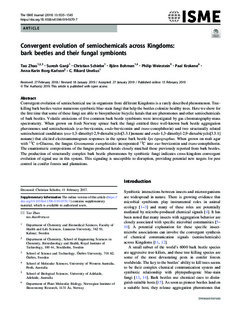| dc.contributor.author | Zhao, Tao | |
| dc.contributor.author | Ganji, Suresh | |
| dc.contributor.author | Schiebe, Christian | |
| dc.contributor.author | Bohman, Björn | |
| dc.contributor.author | Weinstein, Philip | |
| dc.contributor.author | Krokene, Paal | |
| dc.contributor.author | Borg-Karlson, Anna-Karin | |
| dc.contributor.author | Unelius, C. Rikard | |
| dc.date.accessioned | 2019-09-09T13:13:20Z | |
| dc.date.available | 2019-09-09T13:13:20Z | |
| dc.date.created | 2019-06-12T14:50:59Z | |
| dc.date.issued | 2019-02-15 | |
| dc.identifier.citation | The ISME Journal. 2019, 13 1535-1545. | nb_NO |
| dc.identifier.issn | 1751-7362 | |
| dc.identifier.uri | http://hdl.handle.net/11250/2614334 | |
| dc.description.abstract | Convergent evolution of semiochemical use in organisms from different Kingdoms is a rarely described phenomenon. Tree-killing bark beetles vector numerous symbiotic blue-stain fungi that help the beetles colonize healthy trees. Here we show for the first time that some of these fungi are able to biosynthesize bicyclic ketals that are pheromones and other semiochemicals of bark beetles. Volatile emissions of five common bark beetle symbionts were investigated by gas chromatography-mass spectrometry. When grown on fresh Norway spruce bark the fungi emitted three well-known bark beetle aggregation pheromones and semiochemicals (exo-brevicomin, endo-brevicomin and trans-conophthorin) and two structurally related semiochemical candidates (exo-1,3-dimethyl-2,9-dioxabicyclo[3.3.1]nonane and endo-1,3-dimethyl-2,9-dioxabicyclo[3.3.1]nonane) that elicited electroantennogram responses in the spruce bark beetle Ips typographus. When grown on malt agar with 13C D-Glucose, the fungus Grosmannia europhioides incorporated 13C into exo-brevicomin and trans-conophthorin. The enantiomeric compositions of the fungus-produced ketals closely matched those previously reported from bark beetles. The production of structurally complex bark beetle pheromones by symbiotic fungi indicates cross-kingdom convergent evolution of signal use in this system. This signaling is susceptible to disruption, providing potential new targets for pest control in conifer forests and plantations. | nb_NO |
| dc.language.iso | eng | nb_NO |
| dc.rights | Navngivelse 4.0 Internasjonal | * |
| dc.rights.uri | http://creativecommons.org/licenses/by/4.0/deed.no | * |
| dc.title | Convergent evolution of semiochemicals across Kingdoms: bark beetles and their fungal symbionts | nb_NO |
| dc.type | Journal article | nb_NO |
| dc.type | Peer reviewed | nb_NO |
| dc.description.version | publishedVersion | nb_NO |
| dc.rights.holder | © The Author(s) 2019. This article is published with open access | nb_NO |
| dc.subject.nsi | VDP::Landbruks- og Fiskerifag: 900::Landbruksfag: 910::Skogbruk: 915 | nb_NO |
| dc.source.pagenumber | 1535-1545 | nb_NO |
| dc.source.volume | 13 | nb_NO |
| dc.source.journal | The ISME Journal | nb_NO |
| dc.identifier.doi | 10.1038/s41396-019-0370-7 | |
| dc.identifier.cristin | 1704405 | |
| dc.relation.project | Norges forskningsråd: 249958 | nb_NO |
| cristin.unitcode | 7677,3,0,0 | |
| cristin.unitname | Divisjon for bioteknologi og plantehelse | |
| cristin.ispublished | true | |
| cristin.fulltext | original | |
| cristin.qualitycode | 2 | |

